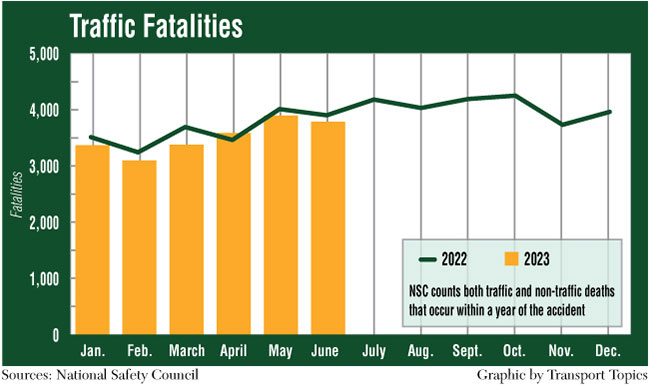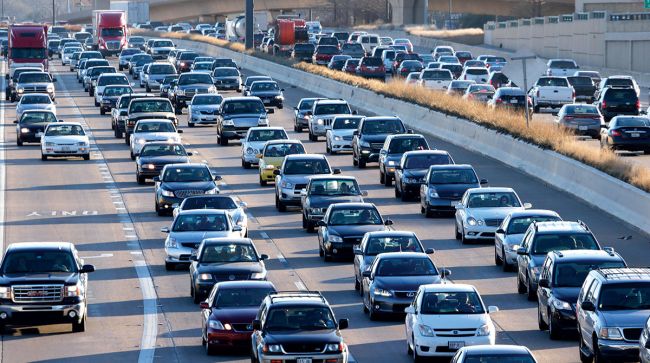Traffic fatalities declined by an estimated 3% during the first six months of 2023 while miles traveled by American motorists increased 2.3% across the same period of time, a new report found.
The National Safety Council in an Aug. 25 report said that a combination of a decrease in fatalities and an increase in mileage worked out to a mileage death rate of 1.34 people per 100 million vehicle miles, a 5.6% decrease from 1.42 people per 100 million vehicle miles in 2022.
In actual numbers, there were 21,130 traffic fatalities from the beginning of January through the end of June, down from 21,870 deaths during the first six months of 2022.
“While there is a glimmer of hope that progress is being made, these estimates are still a stark reminder of the work that lies ahead,” said Mark Chung, the group’s executive vice president of roadway practice. The group noted that the final six months of the year are historically more likely to see an increase in fatal crashes on roadways as more people are traveling.

During the first half of this year, the report said nine states saw a more than 15% decline in year-over-year traffic deaths compared to 2022.
Maine saw the biggest decline, down 48%, followed by a 26% decline in Nebraska. Hawaii saw traffic fatalities fall 23%, while New Jersey saw a 20% decline and Alaska reported a 19% dip. California and Massachusetts each saw a 17% decline, and Georgia and New York were each down 16%.
Stacy Tetschner is president and CEO of the Fredericksburg, Va.-based American Traffic Safety Services Association. He told Transport Topics the decline is an encouraging trend, as he believes drivers are focusing more attention on the road and less on their phones when they’re driving.
“People are getting more focused on the road. There is less distracted driving,” he said. “I’m not saying we have eliminated distracted driving, but there is less of it and we are a lot better than we were this time last year.”
ATSSA is a member of the Road to Zero Coalition, a group of traffic safety stakeholders led by the National Safety Council with a goal of dramatically decreasing highway and road deaths to zero by 2050. Tetschner’s organization is focused on reducing accidents in highway and road work zones.
With billions of federal dollars being allocated to improve the nation’s road infrastructure, Tetschner said many more road engineers and workers will be repaving and rebuilding roads and bridges for several years. That means it’s up to drivers to look out for them.
“We are still seeing too much speeding in work zones,” he said. “We know it’s a pain in the backside to go through a work zone, but those people are trying to make the roads safer and make them better. With a little bit of patience we can rebuild the roads and, more importantly, get everyone home safe.”
NSC urges all drivers to share the road responsibly by following these safety tips:
• Prepare before you go
• Buckle up
• Designate a sober driver or arrange alternate transportation
• Slow down
• Drive distraction-free
• Look before you lock
• Demand safer roads— National Safety Council (@NSCsafety) August 28, 2023
Tetschner added, “Anytime things on the roads get a bit better, that means a few more people get home safe.”
Still, the NSC report noted that nine states and Washington, D.C., saw an increase in road deaths of more than 10% year-over-year, with Rhode Island’s numbers soaring by 164% and Arizona posting a 69% jump. Washington, D.C., saw a 29% rise. Wyoming and Idaho saw fatalities rise 20%, while South Dakota saw a 14% uptick and Iowa recorded a 13% gain. North Dakota and Kentucky were up 11% and Maryland saw a 10% increase.
Stakeholders note that drivers need to ensure they’re focused on the road to prevent crashes from occurring in the first place.
Richard Ginkowski, a municipal judge in Kenosha County, Wisconsin, noted that drivers during the COVID-19 pandemic felt they had a sense of invulnerability, leading to a dramatic increase in the number of drivers in his courtroom who were arrested for driving 40, 50 and sometimes 60 mph above the posted speed limit.
“Excessive speeding has reached an epidemic, and reckless driving has increased significantly,” Ginkowski said. “We’re not talking about people driving 10 miles over the limit, we’re talking about too many drivers driving their cars in the triple digits. And when they get into traffic crashes they are going to the county morgue instead of the emergency room.”
“We should be sure we are buckling up, driving the speed limit and being fully attentive and avoiding distractions and really making driving a priority, instead of looking at our phones as we’re on the highway,” added Virginia Tech Transportation Institute Executive Director Zac Doerzaph.






